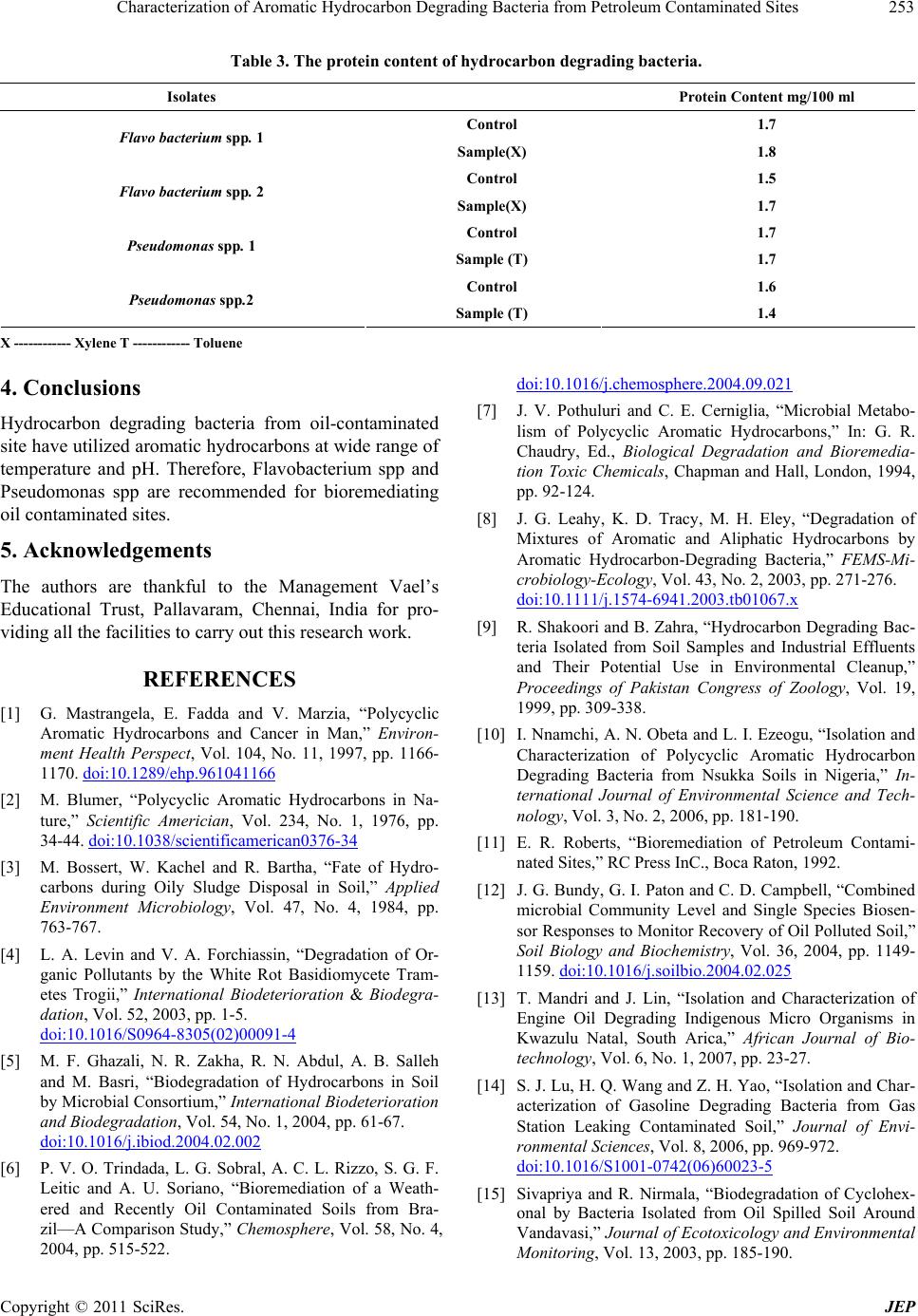
Characterization of Aromatic Hydrocarbon Degrading Bacteria from Petroleum Contaminated Sites
Copyright © 2011 SciRes. JEP
253
Table 3. The protein conte nt of hydrocarbon degr ading bacteria.
Isolates Protein Content mg/100 ml
Control 1.7
Flavo bacterium spp. 1 Sample(X) 1.8
Control 1.5
Flavo bacterium spp. 2 Sample(X) 1.7
Control 1.7
Pseudomonas spp. 1 Sample (T) 1.7
Control 1.6
Pseudomonas spp.2 Sample (T) 1.4
X ------------ Xylene T ---------- -- Toluene
4. Conclusions
Hydrocarbon degrading bacteria from oil-contaminated
site have utilized aromatic hydrocarbons at wide range of
temperature and pH. Therefore, Flavobacterium spp and
Pseudomonas spp are recommended for bioremediating
oil contaminated sites.
5. Acknowledgements
The authors are thankful to the Management Vael’s
Educational Trust, Pallavaram, Chennai, India for pro-
viding all the facilities to carry out this research work.
REFERENCES
[1] G. Mastrangela, E. Fadda and V. Marzia, “Polycyclic
Aromatic Hydrocarbons and Cancer in Man,” Environ-
ment Health Perspect, Vol. 104, No. 11, 1997, pp. 1166-
1170. doi:10.1289/ehp.961041166
[2] M. Blumer, “Polycyclic Aromatic Hydrocarbons in Na-
ture,” Scientific Americian, Vol. 234, No. 1, 1976, pp.
34-44. doi:10.1038/scientificamerican0376-34
[3] M. Bossert, W. Kachel and R. Bartha, “Fate of Hydro-
carbons during Oily Sludge Disposal in Soil,” Applied
Environment Microbiology, Vol. 47, No. 4, 1984, pp.
763-767.
[4] L. A. Levin and V. A. Forchiassin, “Degradation of Or-
ganic Pollutants by the White Rot Basidiomycete Tram-
etes Trogii,” International Biodeterioration & Biodegra-
dation, Vol. 52, 2003, pp. 1-5.
doi:10.1016/S0964-8305(02)00091-4
[5] M. F. Ghazali, N. R. Zakha, R. N. Abdul, A. B. Salleh
and M. Basri, “Biodegradation of Hydrocarbons in Soil
by Microbial Consortium,” International Biodeterioration
and Biodegradation, Vol. 54, No. 1, 2004, pp. 61-67.
doi:10.1016/j.ibiod.2004.02.002
[6] P. V. O. Trindada, L. G. Sobral, A. C. L. Rizzo, S. G. F.
Leitic and A. U. Soriano, “Bioremediation of a Weath-
ered and Recently Oil Contaminated Soils from Bra-
zil—A Comparison Study,” Chemosphere, Vol. 58, No. 4,
2004, pp. 515-522.
doi:10.1016/j.chemosphere.2004.09.021
[7] J. V. Pothuluri and C. E. Cerniglia, “Microbial Metabo-
lism of Polycyclic Aromatic Hydrocarbons,” In: G. R.
Chaudry, Ed., Biological Degradation and Bioremedia-
tion Toxic Chemicals, Chapman and Hall, London, 1994,
pp. 92-124.
[8] J. G. Leahy, K. D. Tracy, M. H. Eley, “Degradation of
Mixtures of Aromatic and Aliphatic Hydrocarbons by
Aromatic Hydrocarbon-Degrading Bacteria,” FEMS-Mi-
crobiology-Ecology, Vol. 43, No. 2, 2003, pp. 271-276.
doi:10.1111/j.1574-6941.2003.tb01067.x
[9] R. Shakoori and B. Zahra, “Hydrocarbon Degrading Bac-
teria Isolated from Soil Samples and Industrial Effluents
and Their Potential Use in Environmental Cleanup,”
Proceedings of Pakistan Congress of Zoology, Vol. 19,
1999, pp. 309-338.
[10] I. Nnamchi, A. N. Obeta and L. I. Ezeogu, “Isolation and
Characterization of Polycyclic Aromatic Hydrocarbon
Degrading Bacteria from Nsukka Soils in Nigeria,” In-
ternational Journal of Environmental Science and Tech-
nology, Vol. 3, No. 2, 2006, pp. 181-190.
[11] E. R. Roberts, “Bioremediation of Petroleum Contami-
nated Sites,” RC Press InC., Boca Raton, 1992.
[12] J. G. Bundy, G. I. Paton and C. D. Campbell, “Combined
microbial Community Level and Single Species Biosen-
sor Responses to Monitor Recovery of Oil Polluted Soil,”
Soil Biology and Biochemistry, Vol. 36, 2004, pp. 1149-
1159. doi:10.1016/j.soilbio.2004.02.025
[13] T. Mandri and J. Lin, “Isolation and Characterization of
Engine Oil Degrading Indigenous Micro Organisms in
Kwazulu Natal, South Arica,” African Journal of Bio-
technology, Vol. 6, No. 1, 2007, pp. 23-27.
[14] S. J. Lu, H. Q. Wang and Z. H. Yao, “Isolation and Char-
acterization of Gasoline Degrading Bacteria from Gas
Station Leaking Contaminated Soil,” Journal of Envi-
ronmental Sciences, Vol. 8, 2006, pp. 969-972.
doi:10.1016/S1001-0742(06)60023-5
[15] Sivapriya and R. Nirmala, “Biodegradation of Cyclohex-
onal by Bacteria Isolated from Oil Spilled Soil Around
Vandavasi,” Journal of Ecotoxicology and Environmental
Monitoring, Vol. 13, 2003, pp. 185-190.